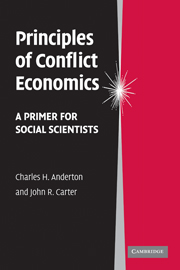Book contents
- Frontmatter
- Contents
- List of Figures
- List of Tables
- Preface
- 1 Introduction: Definition and Scope of Conflict Economics
- 2 Production Possibilities and the Guns versus Butter Trade-Off
- 3 Rational Choice and Equilibrium
- 4 Fundamentals of Game Theory
- 5 A Bargaining Model of Conflict
- 6 Conflict between States
- 7 Civil War and Genocide
- 8 Terrorism
- 9 Geography and Technology of Conflict
- 10 Arms Rivalry, Proliferation, and Arms Control
- 11 Military Alliances
- 12 Conflict Success Functions and the Theory of Appropriation Possibilities
- Appendix A Statistical Methods
- Appendix B A More Formal Bargaining Model of Conflict
- References
- Author Index
- Subject Index
Appendix B - A More Formal Bargaining Model of Conflict
Published online by Cambridge University Press: 05 June 2012
- Frontmatter
- Contents
- List of Figures
- List of Tables
- Preface
- 1 Introduction: Definition and Scope of Conflict Economics
- 2 Production Possibilities and the Guns versus Butter Trade-Off
- 3 Rational Choice and Equilibrium
- 4 Fundamentals of Game Theory
- 5 A Bargaining Model of Conflict
- 6 Conflict between States
- 7 Civil War and Genocide
- 8 Terrorism
- 9 Geography and Technology of Conflict
- 10 Arms Rivalry, Proliferation, and Arms Control
- 11 Military Alliances
- 12 Conflict Success Functions and the Theory of Appropriation Possibilities
- Appendix A Statistical Methods
- Appendix B A More Formal Bargaining Model of Conflict
- References
- Author Index
- Subject Index
Summary
In this appendix we present a linear mathematical version of Hirshleifer's bargaining model of conflict introduced in Chapter 5. We derive a peaceful settlement equilibrium and then show how fighting can emerge as the predicted outcome based on inconsistent expectations, preemption, or preventive war. Throughout the appendix we assume that each player is risk neutral and that an interior solution holds.
Basic Model of Resource Conflict
We begin with the resource conflict model of Chapter 12, which is a variation of a model due originally to Skaperdas (2006). Assume players A and B have respective holdings of secure and undisputed resources RA and RB, but they dispute control of a fixed resource. The players divert MA and MB units of their respective secure resources to produce military goods, which in turn can be used to fight over the disputed resource. Each diverted unit generates one unit of military goods, and fighting destroys a fixed proportion δ of the disputed resource, where 0 < δ < 1.
Net Resource Functions under Fighting
Let pA be A's conflict success in the resource dispute, with pB the same for B. We assume conflict success is measured by the proportion of the disputed resource controlled by a player, although it could be interpreted as the probability that a player controls the entire resource in a winner-take-all contest.
- Type
- Chapter
- Information
- Principles of Conflict EconomicsA Primer for Social Scientists, pp. 277 - 284Publisher: Cambridge University PressPrint publication year: 2009



